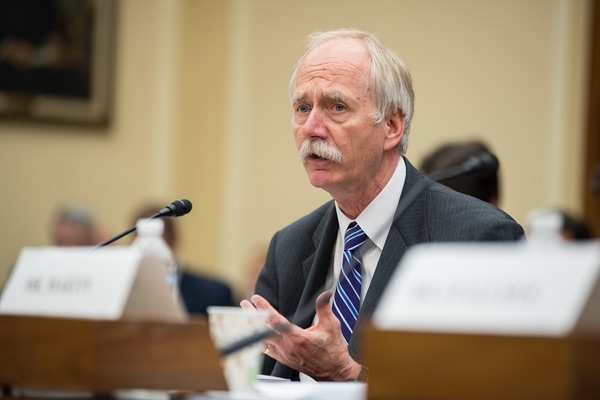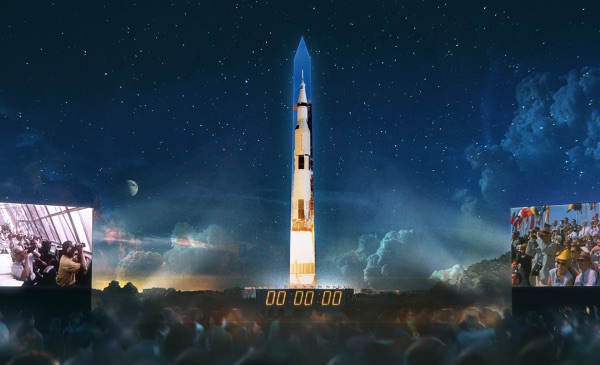An exploration shakeupby Jeff Foust
|
| “I just thought it was important to make this decision, make this change at this time,” Bridenstine said. |
But late last week, all the space community could talk about was not the upcoming celebrations but a shakeup a few blocks from the National Air and Space Museum at NASA Headquarters. Late Wednesday, NASA administrator Jim Bridenstine announced in an internal memo that he was reassigning two top officials involved in NASA’s exploration program. Bill Gerstenmaier, the longtime associate administrator for human exploration and operations, would now be a special advisor to deputy administrator Jim Morhard. Bill Hill, deputy associate administrator for exploration systems development, was similarly reassigned to be a special advisor to associate administrator Steve Jurczyk.
That memo offered few details about why Gerstenmaier and Hill were being reassigned—effectively demoted, if not fired, in the eyes of most within NASA and in the space industry. “As you know, NASA has been given a bold challenge to put the first woman and the next man on the Moon by 2024, with a focus on the ultimate goal of sending humans to Mars,” Bridenstine wrote. “In an effort to meet this challenge, I have decided to make leadership changes to the Human Exploration and Operations (HEO) Mission Directorate.”
Few, if anyone, saw such a change coming. On Wednesday morning, Gerstenmaier testified before the House Science Committee’s space subcommittee at a hearing about NASA’s low Earth orbit commercialization strategy. Nothing seemed amiss in his testimony, and Gerstenmaier lingered after the hearing ended, talking with committee members and other attendees.
It certainly took members of that committee by surprise. “I was surprised about the administrator’s announcement,” said Rep. Kendra Horn (D-OK), chair of the space subcommittee, in a statement Thursday, adding she was “concerned about the impacts that such abrupt leadership changes in our nation’s human spaceflight programs could have.”
NASA made no public announcement of the reassignments beyond the memo. In interviews over the next two days, though, Bridenstine said the urgency of the goal the administration placed on NASA—landing humans on the south pole of the Moon by 2024—required the agency to move quickly to keep the program on track.
“We’re moving to a new era in human spaceflight where the administration is interested in going fast, we’re interested in doing things in a different way, and I believed it was important to have new leadership at the top of the Human Exploration and Operations Mission Directorate,” Bridenstine said in an interview Friday on C-SPAN. “I just thought it was important to make this decision, make this change at this time.”
But why now, exactly? That was the question many in the industry continued to ask, wondering if there was a precipitating event of some kind that prompted the reassignments. Was there some kind of report that offered bad news about the development of SLS and Orion, or commercial crew? Was there a directive from a White House dissatisfied with the pace of development?
Bridenstine appeared to dismiss the latter scenario. “It was entirely my decision,” he said in the C-SPAN interview. “At the end of the day, we need to be very clear that NASA is committed to cost and schedule. Safety is the highest priority, but we are committed to cost and schedule, and I just thought it was important to make this change at this time.” Bridenstine emphasized “cost and schedule” throughout the interview.
 Bill Gerstenmaier testifying at a Hpuse hearing last Wednesday, hours before NASA announced he was being reassigned from his longtime position of associate administrator for human exploration and operations. (credit: NASA/Aubrey Gemignani) |
Gerstenmaier, who had been associate administrator for human exploration and operations since that mission directorate formed in 2011 with the merger of the exploration and space operations directorates, was widely admired within and outside NASA for his technical expertise in human spaceflight and no-nonsense assessments of both the agency’s achievements and challenges. He won a wide range of awards for his service to NASA, including an honorary doctorate from his alma mater, Purdue University, earlier this year.
| “Everybody can be on board when everything is going forward and there’s an infinite amount of new money coming into the agency, but we had a series of meetings already where we’re starting to discuss what other things can we cut,” Gerstenmaier said in May. |
Those assessments, though, could run into conflict with other agency statements. At a May 31 meeting of the NASA Advisory Council, he offered a cautionary note about the agency’s future budgets. NASA requested $1.6 billion in additional funding for fiscal year 2020, which it says will allow it to carry out work on the lunar landers for the Artemis program and other efforts without affecting other agency programs.
“When we get to ’21, I don’t think we’re going to be able to get the entire budget as new money to the top line,” Gerstenmaier said at that meeting. “We’re going to have to look for some efficiencies and make some cuts internal to the agency, and that’s where it’s going to be hard.”
That included, he said, cuts both within the exploration program and outside of it. “Everybody can be on board when everything is going forward and there’s an infinite amount of new money coming into the agency, but we had a series of meetings already where we’re starting to discuss what other things can we cut, or where can we slow some things down to focus.”
The agency responded with a statement a few days later reiterating its public stance that other parts of NASA won’t be raided to pay for Artemis: “The administrator said we would not raid science to pay for Artemis and that is the agency’s position.”
What still isn’t clear, though, is how much Artemis will cost. In an interview with CNN last month, Bridenstine estimated NASA would need $20–30 billion on top of earlier budget projections to get humans on the Moon by 2024. Neither Bridenstine nor the agency has elaborated on their projection, including what the funding profile would look like beyond 2020.
Bridenstine, in the C-SPAN interview, backed away from that cost estimate somewhat, suggesting it could be done for less if commercial partners come on board. “What we’re learning is that there are other people that want to contribute to this,” he said. “They want to invest their own money. Why? Because they want customers that are not NASA. If they have customers that are not NASA, it drives down our costs.” He added it was “very realistic” for its cost to be less than $20 billion.
NASA has yet to secure any new funding for Artemis. The House didn’t act on the $1.6 billion budget amendment when it took up its fiscal year 2020 commerce, justice, and science appropriations bill, which funds NASA. That wasn’t a surprise, he said in the interview, because the budget amendment was released the same week as an appropriations subcommittee took up the bill.
“I’ve talked to people on both sides of the aisle that are, in fact, very, very supportive,” he said of House members. “The challenge is they just didn’t have the time.” Instead, he’s hoping the Senate includes the funding in its version of a spending bill. The Senate, though, has yet to start work on a fiscal year 2020 spending bill.
“The process has only just begun,” Bridenstine said. “I’m confident that it can be achieved.”
And, while Bridenstine said the reassignments were his decision alone, he knows the overall Artemis program is getting attention from the White House. On June 7, President Trump chimed in on Twitter in a statement that appears to throw everyone, including NASA, off guard. “For all of the money we are spending, NASA should NOT be talking about going to the Moon – We did that 50 years ago,” he wrote. “They should be focused on the much bigger things we are doing, including Mars (of which the Moon is a part), Defense and Science!”
| “He said very clearly, ‘I know you’ve got to go to the Moon to get to Mars, but talk about Mars,’” Bridenstine said of Trump. “We are going to continue talking about why we’re going to the Moon. It’s the proving ground for the mission to Mars.” |
While Trump’s statement seemed to suggest that NASA should not go back to the Moon at all, NASA and administration officials said hours later the president was simply restating the long-term goal of going to Mars. “We have asked Congress for additional resources to get to the Moon by 2024, which will enable us to get to Mars roughly a decade after creating a sustainable presence on the lunar surface,” a White House official, speaking on background said a few hours later.
A day after that tweet, Scott Pace, executive secretary of the National Space Council, offered some additional explanation, arguing that the near-term focus on the Moon meant there wasn’t enough discussion about going to Mars. “I don’t think we always do a good job speaking to the larger vision that this is part of,” he said in a luncheon speech at the National Space Society’s International Space Development Conference. “What he’s doing is stepping back and expressing, I think, a very understandable impatience with how long all of that takes, and sometimes we miss the bigger picture.”
Bridenstine, in the C-SPAN interview, also mentioned he spoke in recent weeks with Trump. “He said very clearly, ‘I know you’ve got to go to the Moon to get to Mars, but talk about Mars,’” Bridenstine said of Trump. “We are going to continue talking about why we’re going to the Moon. It’s the proving ground for the mission to Mars.”
Turning that talk, be it of missions to the Moon or Mars, into action will be the job of new leadership. Gerstenmaier’s deputy, former astronaut Ken Bowersox, will take over as associate administrator for human exploration and operations on an acting basis. Bridenstine said he’s planning a nationwide search to find a permanent replacement, who will then help hire two deputies: one to replace Hill to oversee work on SLS and Orion, and a new deputy responsible for programs like the Gateway and lunar landers.
“We will be looking for them to look at the programs and come up with their own baseline schedules and costs, and then ultimately have them execute to those baselines,” Bridenstine said of that new leadership. He added impending decisions, including whether or not to perform a “green run” test of the SLS core stage—foregoing it could save months of schedule, but increase the program’s risk—will be left to that new leadership.
The Apollo program had its own leadership shakeups before successfully landing humans on the Moon 50 years ago this month. Some came out of the Apollo 1 accident, others from various problems and conflicts among the agency, its contractors, and the White House. As the nation celebrates the accomplishments of Apollo this week, we’re reminded that achievement had plenty of challenges—and that Artemis will be no different.
Note: we are temporarily moderating all comments subcommitted to deal with a surge in spam.
